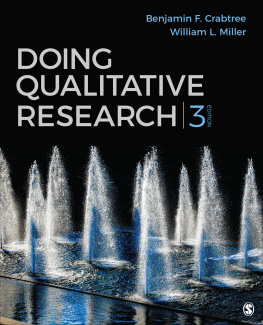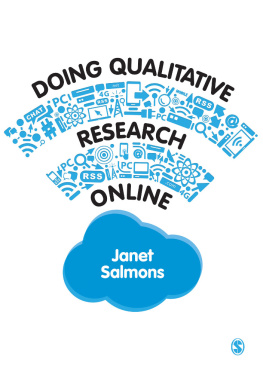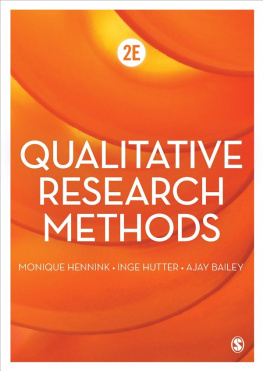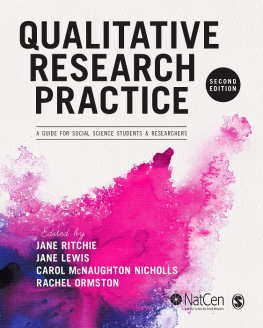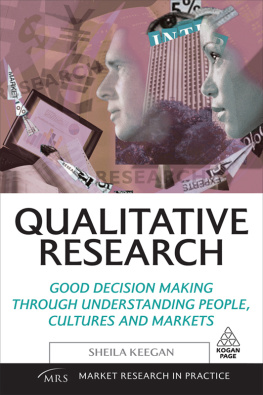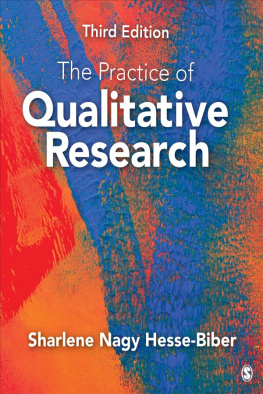Sara Miller McCune founded SAGE Publishing in 1965 to support the dissemination of usable knowledge and educate a global community. SAGE publishes more than 1000 journals and over 800 new books each year, spanning a wide range of subject areas. Our growing selection of library products includes archives, data, case studies and video. SAGE remains majority owned by our founder and after her lifetime will become owned by a charitable trust that secures the companys continued independence.
Los Angeles | London | New Delhi | Singapore | Washington DC | Melbourne
Cecilia Vindrola-Padros 2021
Apart from any fair dealing for the purposes of research, private study, or criticism or review, as permitted under the Copyright, Designs and Patents Act, 1988, this publication may not be reproduced, stored or transmitted in any form, or by any means, without the prior permission in writing of the publisher, or in the case of reprographic reproduction, in accordance with the terms of licences issued by the Copyright Licensing Agency. Enquiries concerning reproduction outside those terms should be sent to the publisher.
SAGE Publications Ltd
1 Olivers Yard
55 City Road
London EC1Y 1SP
SAGE Publications Inc.
2455 Teller Road
Thousand Oaks, California 91320
SAGE Publications India Pvt Ltd
B 1/I 1 Mohan Cooperative Industrial Area
Mathura Road
New Delhi 110 044
SAGE Publications Asia-Pacific Pte Ltd
3 Church Street
#10-04 Samsung Hub
Singapore 049483
Library of Congress Control Number: 2020952153
British Library Cataloguing in Publication data
A catalogue record for this book is available from the British Library
ISBN 978-1-5264-9737-6
ISBN 978-1-5264-9736-9 (pbk)
At SAGE we take sustainability seriously. Most of our products are printed in the UK using responsibly sourced papers and boards. When we print overseas we ensure sustainable papers are used as measured by the PREPS grading system. We undertake an annual audit to monitor our sustainability.
Editor: Alysha Owen
Senior assistant editor: Charlotte Bush
Production editor: Victoria Nicholas
Marketing manager: Ben Griffin-Sherwood
Cover design: Candice Harman
Typeset by: diacriTech
Printed in the UK
To my beautiful Julian,
for teaching me to see the world in a different way.
Introduction
Many years ago, I was approached by a senior manager in a childrens hospital who was looking for a research team to evaluate a new service he had implemented in the hospital. The purpose of the new service was to deliver some of the care required by patients as an outpatient service, reducing the need for children and their parents to be admitted to the hospital. A few months after the service had been rolled out, it was not providing care to the number of patients that had originally been estimated. This low number of patient cases was mainly due to staff members unwillingness and inability to refer patients to the service.
I was asked to put together a team to carry out a diagnostic study to identify the main reasons why staff were not referring patients to the service. The caveat was that important decisions would need to be made about continuing or discontinuing the service at the next Board meeting. This meant findings would need to be delivered in two months. From my point of view, this meant I would need to assemble a team, design a study protocol, collect data, analyse it and disseminate it in a user-friendly way in less than eight weeks.
It was not an easy process, but we managed to carry out a rapid appraisal of the main barriers to referral. We carried out interviews with staff, observed referral processes and the delivery of care in the outpatients area and conducted documentary analysis. We developed a visual summary of the findings (similar to an infographic) and shared them by the deadline. The Board decided to continue with the service provided that the service leads develop action plans to address each of the referral barriers we had identified in our evaluation. The main changes that needed to be made were the development of better educational materials for hospital staff in relation to the services the outpatient clinic could provide, the simplification of the paperwork required to refer patients (as some staff found this to be too time consuming) and the creation of a follow-up system where staff who referred patients to the outpatient service would be informed about these patients outcomes after they were seen as outpatients. This was my first exposure to rapid qualitative research and, needless to say, I fell in love with this field.
We (by we I mean our research team that has recently become the Rapid Research Evaluation and Appraisal Lab [RREAL]) then went on to design and implement a wide range of rapid studies, including rapid ethnographies, rapid appraisals, rapid evaluations and rapid assessment procedures (RAPs). We reviewed the work others had done with these approaches (Johnson and Vindrola-Padros, 2017; Vindrola-Padros and Johnson, 2020; Vindrola-Padros and Vindrola-Padros, 2018; Vindrola-Padros et al., 2021) and sought ways to experiment with methods and advance the field of rapid qualitative research. We started being approached by other researchers, practitioners and students interested in the work and became aware of the need for formal training on these topics. We developed training courses for postgraduate students, clinicians, social scientists and managers, and it was at this point that we recognised the value of bringing together all of this information, our research experiences, previous studies, questions posed by our students, into one book.
The aim of the book is to develop capacity in the design, implementation, dissemination and use of findings generated through rapid qualitative research. I provide an overview of how these approaches have been used in the past, discuss the challenges of conducting rapid qualitative research through the use of real-world examples presented in the form of case studies and provide practical advice and guidelines for carrying out rapid and rigorous research. I also engage critically with this field, underscoring its main problems and limitations as well as situations when rapid approaches might not be suitable. I mainly focus on qualitative research but include examples of the collection and analysis of quantitative data, where relevant.


